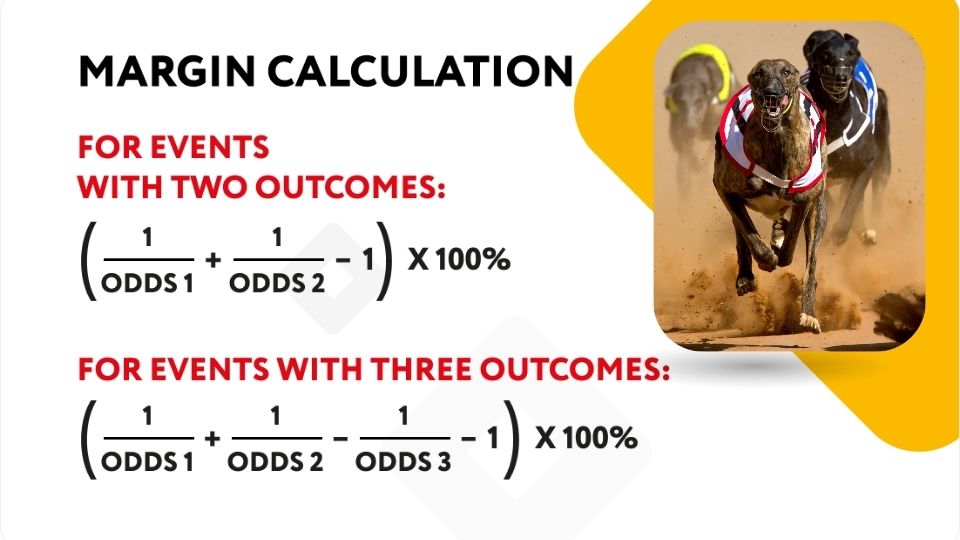Calculating racing odds in Greyhounds involves a combination of analytical techniques and historical data to assess the potential winning chances of each greyhound participating in a race. This process can be broken down into several components including understanding the betting market, analyzing greyhound form, and scrutinizing race conditions.
Understanding the Betting Market
The betting market reflects the collective opinions of bookmakers and punters about the odds of success for greyhounds in a race. When betting on greyhound races, you’ll encounter several types of odds systems, such as:
- Decimal odds: The common European format where odds represent both the potential winnings and the amount to be wagered. A winning greyhound at 5.0 odds means you’ll win £5 for every £1 you bet.
- Fractional odds: Seen in UK betting, these odds represent the proportion of your potential winnings to the stake. For instance, a 4/1 odds mean you’ll win £4 for a £1 bet.
- Moneyline odds: The North American format, represented as positive (+) or negative (-) values. A +200 means you’d win $200 with a $100 bet.
Analyzing Greyhound Form
A crucial aspect of calculating Greyhound racing odds is analyzing the form of each greyhound. Factors to consider include:
- Age: Younger greyhounds are typically faster, but their performances can be more inconsistent. Older dogs have experience on their side, although their speed may decline over time.
- Weight: A greyhound’s racing weight can significantly impact its performance. Changes in weight may indicate fitness levels, offseason training, or other factors.
- Times: The overall speed and sectional times give you an understanding of a greyhound’s strengths and weaknesses. Compare times against race competitors and track records to assess a dog’s chances.
- Grading: Classifying dogs according to their racing abilities allows you to evaluate those performances against similar-grade competitors.
To deepen your analysis, dig into greyhound pedigrees and consider factors such as sire and dam performance, recent races, and previous race distances.
Race Conditions
Various external factors impact greyhound race odds, such as:
- Track surface: The quality of the track can affect greyhounds differently. Some dogs perform better on particular surfaces, and tracks may have distinct biases favouring specific running styles.
- Weather: Weather conditions, like rain, may influence individual performances, as certain dogs can cope better with certain conditions.
- Trap draw: Each dog’s starting position – or trap – is randomly assigned, and each trap may have inherent advantages or disadvantages. The angle of entry and proximity to the rail can create overtaking opportunities or challenges.
Carefully consider these factors when calculating racing odds to find potential value bets that may not be immediately apparent.
Utilizing Advanced Methods and Ratings
Performance ratings and other advanced methods can further aid your greyhound racing odds calculations. These include:
- Pace ratings: These quantify the likely position of a greyhound through the initial stages of a race, helping assess early-race competition or any potential trouble.
- Form ratings: A single value representing a dog’s overall performance, considering factors such as age, weight, recent races, and breeding. Higher form ratings indicate a more likely winner.
These methods can help you create a more sophisticated understanding of the greyhound betting market and derive value from your odds calculations.
After considering the betting market, greyhound form, race conditions, and utilizing advanced methods and ratings, you can develop a comprehensive understanding of greyhound racing odds. This knowledge is invaluable for placing smarter, more informed bets on greyhound races.
Trackside Bookmaker’s Odds Calculations
Trackside bookmakers are an integral part of the greyhound racing experience. They are the professionals who calculate odds for each race and play a direct role in shaping the betting market. Understanding how the trackside bookmakers calculate the betting odds can provide a deeper insight into the greyhound betting process. Their process generally involves the following steps:
- Initial Evaluation: The process begins with a qualitative assessment of the racing greyhounds. This involves evaluating parameters such as the greyhound’s age, speed, past performance, and grading. Any known information about the greyhound’s current form and condition is also taken into account.
- Standardization: To aggregate and compare information from different sources, bookmakers often standardize the collected data into a comparable format. This would typically involve converting past performance data into a speed rating or a form rating.
- Modeling: Bookmakers often have sophisticated statistical models that use the input data to calculate a probability for each greyhound. This involves considering the weights of different factors based on their perceived importance in determining race outcomes, as well as accounting for correlations and interactions between these factors.
- Margin Addition: Bookmakers add a margin or overround to the odds they offer to ensure a profit regardless of the outcome. This involves adjusting the odds in their favor by a certain percentage, ensuring they make a profit in the long run.
- Odds Finalization: The calculated odds are compared with other bookmakers’ odds, the betting exchange market, and any other relevant information source. These comparisons may be used to adjust the odds further before finalizing them.
It’s worth noting that different bookmakers may have different approaches to calculating odds, and the specific methods and models they use are often closely guarded secrets.
Factors Influencing Bookmaker’s Odds Calculation
Let’s dive a bit deeper into the factors bookmakers consider:
- Past Performance: The greyhound’s recent racing history and outcomes are major factors. The bookmakers look into the details such as finishing times, distances, and field strengths of these previous races.
- Grade: Greyhounds are graded based on their performance. Higher-grade dogs typically have shorter odds than lower-graded ones.
- Draw: The trap each dog drawn in might influence their chances. Some tracks have a bias towards certain trap numbers.
- Form: A dog in good form, running well in its recent races, will often be considered a better bet and thus have shorter odds.
- Field Strength: The strength of the field that the dog has raced against before is a major consideration. Beating strong competitors can signify quality performance.
- Track Conditions: Track conditions, such as the track surface and weather, can affect a greyhound’s performance. This information can influence the greyhound’s odds.
- Distance: Distance of the race is an important factor. Some dogs perform better over certain distances.
This information, combined with other specific details about the greyhound and the race, allows bookmakers to calculate the odds as accurately as possible, while ensuring they retain an edge to ensure profitability. Although they
might calculate odds differently, understanding the basic principles behind their methodology can give you a distinct advantage as a punter.
How Online Betting Companies Calculate Odds Using Software
Online betting companies utilize sophisticated, automated systems to calculate odds for greyhound races. These software systems have revolutionized the betting industry by enabling more accurate odds, faster updates, and the ability to process an enormous amount of data in real-time. Here is the general process:
1. Data Collection and Analysis
Online betting companies collect vast amounts of data to evaluate each greyhound’s performance in a race. The information ranges from basics such as age and weight to more specific data including sectional times, previous victories, past form, grade, and even the weather condition on the race day.
2. Implementation of Algorithms and Statistical Models
The next step involves inputting this data into algorithmic models. These models consider the factors relevant to predicting race outcomes and weigh them accordingly. The software uses complex statistical analyses and probability theories to determine the likelihood of each possible outcome.
3. Computation of ‘True Odds’
Given all these conditions and information, the software then calculates what are referred to as the ‘true odds.’ These actual odds represent each greyhound’s statistical likelihood of winning the race.
4. Inclusion of the Overround
To ensure profitability, betting companies apply an overround or margin to these true odds. Essentially, the overround means that the total implied probability of all outcomes, when calculated using the given odds, is greater than 100%. This extra percentage is the bookmaker’s theoretical profit margin.
5. Odds Adjustment
The software also continually adjusts odds leading up to a race based on incoming wagers. If many bettors are placing their bets on a specific greyhound, its odds become shorter to limit potential payouts, and the odds for the other greyhounds are lengthened to encourage bets. This dynamic adjustment of odds based on bet flows is known as balancing the book.
6. Final Odd Offer
The calculated and adjusted odds are then provided on the betting company’s website as the final odds offer for each greyhound. These final odds can be displayed as decimal, fractional, or moneyline (also known as American) format, based on the bettor’s preference or regional norms.
Supercharging Odds Calculation with AI/ML Technology
In recent years, the application of AI and Machine Learning (ML) in odds calculation is becoming increasingly prevalent. AI/ML-powered software can learn from past data, identify patterns, and predict outcomes more accurately to help refine the odds even further.
These systems can dig deeper into the data — factoring in unique variables such as running style, career phase, sister-track performance, and many more, giving a new level of sophistication and accuracy in odds-making.
By understanding how online betting companies use software for their odds calculation, you can gain a deeper insight into the intricacies of greyhound betting and potentially enhance your betting strategy.
Example: Calculating Odds for Sand Burner
Let’s imagine we have a greyhound named Sand Burner, who is participating in an upcoming race. We will create a scenario for his experience, previous results, and other factors, followed by calculating odds for his performance.
Sand Burner’s Profile:
- Age: 3 years old
- Weight: 71 lbs (32 kg)
- Grade: A3
- Running Style: Rail-hugger (prefers to run close to the inside rail)
- Current Form: Good (coming off two wins)
Sand Burner’s Last Five Race Results:
| Race | Date | Track | Grade | Distance | Time | Trap | Position | Comment |
|---|---|---|---|---|---|---|---|---|
| 1 | 01/20/2022 | A | A4 | 500M | 30.00 | 1 | 1 | Led Throughout |
| 2 | 01/10/2022 | A | A4 | 500M | 30.25 | 2 | 1 | Strong Finish |
| 3 | 12/30/2021 | A | A4 | 460M | 28.20 | 5 | 2 | Close 2nd |
| 4 | 12/21/2021 | B | A4 | 500M | 30.50 | 1 | 3 | Slow off, ran on |
| 5 | 11/30/2021 | A | A4 | 500M | 30.60 | 2 | 3 | Kept on |
Step 1: Initial Evaluation based on Sand Burner’s Profile
Given his age and weight, Sand Burner is in the prime stage of his racing career. He has a strong grade (A3) and is displaying good form and consistent results.
Step 2: Analyzing Past Performance
Sand Burner has won his two most recent races in Grade A4, and he has managed to achieve good times and positions in other races. He has shown consistency in his running times over the same distance.
Step 3: Calculating the ‘True Odds’
For illustration purposes, let’s assume that our calculations and statistical models, taking into account Sand Burner’s profile and other race parameters, result in the following probability of him winning:
- Winning Probability: 35%
To convert this probability into ‘true odds,’ we use the following formula:
- True Odds = (1 / Probability) × 100
In this case:
- True Odds = (1 / 0.35) × 100 = 2.857 ~ 2.86 (in decimal format)
Step 4: Inclusion of the Overround
Now let’s assume the bookmaker has set an overround of 5% to ensure profitability. We factor this in by dividing the true odds by (1 + overround percentage):
- Adjusted Odds = True Odds / (1 + Overround)
In this case:
- Adjusted Odds = 2.86 / (1 + 0.05) = 2.86 / 1.05 = 2.724 ~ 2.72 (in decimal format)
Apologies for the confusion earlier. You’re correct about the fractional odds being too high. It was a mistake in my calculations. Let’s correct that.
The corrected Step 5 would be as follows:
Step 5: Displaying Odds
The betting company can now display Sand Burner’s odds on their platform in different formats:
- Decimal Odds: 2.72
To derive the fractional format, a simple method would be subtracting one from the decimal odds (to remove the stake), and then finding the closest simple fraction:
- Decimal odds – 1 = 2.72 – 1 = 1.72
While there’s no exact simple fraction equivalent for 1.72, it’s just a little less than 7/4, which is a common fractional odd in racing, so we shall approximate it:
- Fractional Odds: Approximately 7/4
For the Moneyline (American) odds, if the decimal odds are greater than 2.00, we can calculate it this way:
- [(Decimal Odds – 1) 100] = [(2.72 – 1) 100] = +172
- Moneyline (American) Odds: +172
So, given the above, Sand Burner’s final odds would be displayed as:
- Decimal Format: 2.72
- Fractional Format: Approximately 7/4 (or 1.75 in decimal)
- Moneyline/American Format: +172Sure, here’s a simplified breakdown of the process to calculate betting odds for a hypothetical greyhound named Sand Burner:
1. Understand Sand Burner’s Profile:
Firstly, we look at Sand Burner’s personal details such as his age (3 years old), weight (71 lbs), running style (prefers running close to the rail), and current form (he’s in good shape and has won recent races).
2. Review Sand Burner’s Race History:
Next, we look at how Sand Burner performed in his last five races. We see that he has generally done well and is getting faster, placing first in his two most recent races.
3. Calculate the ‘True Odds’:
Using this information along with complex math (factoring in all possible outcomes in the race), we estimate that Sand Burner has a 35% chance of winning his next race. This probability can be converted into ‘true odds’ using a formula. In our example, Sand Burner’s ‘true odds’ would be approximately 2.86
4. Adjust for Profit Margin:
Then, the betting company adds an extra bit, called an overround or margin, to guarantee their profit. After including a 5% overround, the odds for Sand Burner adjust to 2.72.
5. Display the final odds:
Finally, the company shares the adjusted odds on their website. These can be shown in different formats (decimal, fractional, and American), which are simply different ways of expressing the same probability of Sand Burner winning. For our example, Sand Burner’s odds would be:
- Decimal Odds: 2.72
- Fractional Odds: Approximately 7/4
- American Odds: +172
This whole process aims to provide a fair estimate of Sand Burner’s chances of winning, such that it’s attractive for bettors to place a wager, while also ensuring that the betting company can make a profit.
Simplified Version for Beginners
Here’s a simplified breakdown of the process to calculate betting odds for the hypothetical greyhound named Sand Burner:
1. Understand Sand Burner’s Profile:
Firstly, we look at Sand Burner’s personal details such as his age (3 years old), weight (71 lbs), running style (prefers running close to the rail), and current form (he’s in good shape and has won recent races).
2. Review Sand Burner’s Race History:
Next, we look at how Sand Burner performed in his last five races. We see that he has generally done well and is getting faster, placing first in his two most recent races.
3. Calculate the ‘True Odds’:
Using this information along with complex math (factoring in all possible outcomes in the race), we estimate that Sand Burner has a 35% chance of winning his next race. This probability can be converted into ‘true odds’ using a formula. In our example, Sand Burner’s ‘true odds’ would be approximately 2.86
4. Adjust for Profit Margin:
Then, the betting company adds an extra bit, called an overround or margin, to guarantee their profit. After including a 5% overround, the odds for Sand Burner adjust to 2.72.
5. Display the final odds:
Finally, the company shares the adjusted odds on their website. These can be shown in different formats (decimal, fractional, and American), which are simply different ways of expressing the same probability of Sand Burner winning. For our example, Sand Burner’s odds would be:
- Decimal Odds: 2.72
- Fractional Odds: Approximately 7/4
- American Odds: +172
This whole process aims to provide a fair estimate of Sand Burner’s chances of winning, such that it’s attractive for bettors to place a wager, while also ensuring that the betting company can make a profit.
How the abilities of the other greyhounds are factored into the odds calculation
Calculating betting odds is a complex process that takes many factors into account. When considering an individual greyhound, like our example Sand Burner, we initially look at its personal statistics and past performances. However, this is just a part of the overall picture.
The performances of other greyhounds, their form, running conditions, and countless other variables are all considered. Logistic regression, neural networks, and other statistical models are often used to analyze this data and calculate each dog’s chances of winning.
For example, if the other dogs in the race have a record of outstanding performances, this would ultimately decrease Sand Burner’s winning probability, consequently increasing the betting odds, and vice versa.
In simple terms, if the rest of the dogs are highly skilled and have been performing well, the likelihood of Sand Burner winning becomes lesser. This makes it a riskier bet, hence the potential payout (the odds) would be higher to entice betters. On the contrary, if Sand Burner has a notably better performance history than the other dogs, his chances of winning increase, making it a safer bet with lower potential payout.
So, while the abilities and performances of Sand Burner are significant in calculating the odds, it’s essential to understand that these odds are a relative measure against the performance abilities and other factors associated with the other greyhounds in the race.
Historical Approach to Calculating Odds by Bookmakers
Before computers and calculators became widespread, bookmakers had to rely on basic pen-and-paper mathematics, their experience, and intuition to establish betting odds. Here’s a general overview of how they used to do this:
1. Probing Form and Performance:
Just as in the modern-day, early bookmakers had to assess an entrant’s (be it a horse, a dog, or a sports team) form and performance to begin working out their odds. This would involve examining recent performances, conditions on race days, health status, amongst other factors.
2. Observational Inference:
Without the advanced statistical models that computers can run, bookmakers relied significantly on observational inference. Long-time bookies might have knowledge about team rivalries, jockey abilities, track conditions that favored a certain dog or horse, and a wealth of other anecdotal information that they would utilize to adjust odds.
3. Market Sentiment:
Understanding the betting market’s sentiment was essential for early bookmakers. They needed to gauge which way the betting public would sway— this dictated how odds would fluctuate. If a majority of people wagered on a particular team or horse, the odds for that particular bet would go down (as it was considered less risky).
4. Constructing the Book:
Old-time bookmakers constructed their ‘books’ through experience and trial and error. A ‘book’ refers to the total of all bets that the bookmaker has accepted on all possible outcomes. The main aim for the bookmaker was to create an equal-profit scenario regardless of the outcome, much like the overround that we use today.
In those days, bookmakers aimed for what was known as a ’round book’ where each outcome is equally profitable.
5. Manual Calculation:
Once they determined the chances for each outcome, they would then manually calculate the odds using simple fractions. They would often round-up these fractional odds for simplicity, and to ensure their overround.
All in all, it was a much more manual and imprecise system, governed by intuition and experience. The advent of computers and complex algorithms has allowed today’s bookmakers to be far more accurate and efficient in their odds calculation, which in turn benefits bettors, who receive odds that better reflect actual probabilities.




